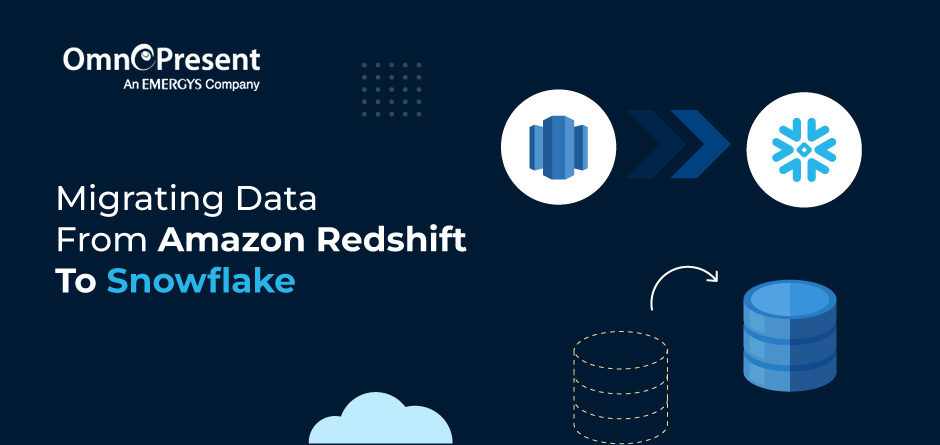
Empowering Businesses with Integrated Mendix Applications and Salesforce
Today businesses are overflowing with data. They require a robust and reliable data warehousing solution to manage and analyze large volumes of data. Redshift and Snowflake are two top cloud-based data warehouses that offer data management and analysis options.
Although Redshift is a powerful tool for businesses, sometimes it can become overly complex, resulting in performance and scalability issues. But Snowflake, an agile data warehousing solution, solves many of these problems, such as limited scalability, data transformation issues, and delays or failures due to high query volumes. It can scale automatically and independently, which is impossible with Redshift. From a business perspective, the best part about Snowflake is that you can scale as you go, minimizing cost and maximizing performance.
Migrating data from Amazon Redshift to Snowflake can be a daunting task. But with the right tools and strategies in place, it doesn’t have to be. This blog article focuses on migrating data from Redshift to Snowflake and provides seamless solutions for you to consider.
Why Migrate from AWS Redshift to Snowflake?
There are many reasons to migrate from AWS Redshift to Snowflake. Snowflake is a cloud-based data warehousing solution offering many advantages over Redshift, including lower costs, higher performance, and better scalability.
Snowflake is also a fully managed service, so you don’t have to worry about managing infrastructure or dealing with complex setups. And because Snowflake runs on top of Amazon Web Services (AWS), you can take advantage of all the security and reliability that AWS offers.
Snowflake’s unique architecture makes it easier to query and analyze data, saving you time and effort when working with large data sets.
Architecture
Snowflake’s multi-cluster shared data architecture delivers the performance, scale, elasticity, and concurrency that today’s organizations need. It features storage, computing, and global services layers that are physically separated but logically integrated. Data workloads scale independently, making it an ideal choice for data warehousing, as Redshift cannot accomplish this.
Management of Cluster (Resizing)
Snowflake automatically does the job of clustering on the tables. This natural clustering process of Snowflake is good enough for most cases and gives good performance even for big tables. This poses some challenges in Redshift, similar to the challenges faced while scaling up or down in Redshift.
Redshift Resize operations can become expensive at times, resulting in significant downtime. Since computation and storage layers are separate in Snowflake, you can simply switch the data computation capacity as necessary. Overall, there’s more management involved with Redshift than with Snowflake.
Database Features
Snowflake simplifies data sharing across different accounts. Thus, you can share the data without copying it first. This is a very efficient approach to working with third-party data. In contrast, Redshift doesn’t currently offer this type of support.
Apart from this, Snowflake also supports semi-structured data types like Object, Array, and Variant. However, these data types are also unsupported by Redshift.
Ease of Management
If you want to set up a data warehousing service that runs itself, choose Snowflake. After connecting to the service, you can start running queries when setting up your data. There is no hardware required.
However, Redshift requires configuration to adapt to your specific set of data. It’s not a set-up-and-go option. Servers must be managed individually and manually.
How to Migrate from AWS Redshift to Snowflake?
Database Objects Migration
The first step is to start with Database objects which primarily include Schema, Table Structures, Views, etc. We should prefer to keep the object’s structure the same instead of making changes while migrating, as it adversely impacts the entire migration process. Later, DB objects must be created in Snowflake with the same structure as Redshift.
Data Migration
This is the most critical activity in migration. The first step is identifying historical data sets for each table and how to migrate them, given the significant data volume.
Create various batches for all tables to migrate data in multiple batches instead of all data in one batch. When historical data for all tables are migrated to the Snowflake, then moving the incremental data will be simple. One approach could be Redshift’s “Unload Command” to unload data into S3 and then use Snowflake’s “Copy Command” to load this data from S3 into Snowflake tables.
Another approach could be using any data replication tool present in the market; raw data from the source system can be migrated using the replication tool and loaded into Snowflake. On top of this raw data, ETL/ELT pipelines can populate facts, dimensions, and Metrics tables on the Snowflake platform.
Code Migration
This step is relatively more straightforward than the above, except for some challenges/limitations. Redshift and Snowflake both support ANSI-SQL but in different formats for various items.
Snowflake has a “VARIANT” datatype for supporting semi-structured data like JSON, AVRO, PARQUET, whereas in Redshift, datatypes like JSON can not be directly stored.
You must create the target table by analyzing the JSON source data to match the JSON field names in Redshift. We must import it directly with a fixed structure. The COPY functions can only parse the first-level elements into the target table. Hence, the multi-level elements are considered strings and loaded into a single column.
Data Comparison Between Redshift and Snowflake
This is the last step for any migration activity to compare the data sets from Redshift and Snowflake to ensure that all migration is completed successfully. Run comparable checks against both the DBs and compare results like record counts, data type comparison, metrics comparison in fact tables, DB object count, duplicate checks, etc.
Wrapping Up
Moving to the cloud requires planning, strategy, and the right tools for data migration. You can migrate data from Redshift to Snowflake on your own, but the nuances of the process demand significant data engineering knowledge.
OmnePresent, a Snowflake consulting partner, can assist in managing all your data management needs with Snowflake and help you accelerate the migration to the Snowflake platform.
RECENT POSTS
CATEGORIES


